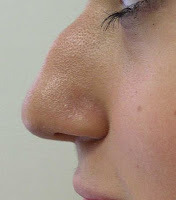Physical Attributes Entry: Noses

Physical description of a character can be difficult to convey—too much will slow the pace or feel 'list-like', while too little will not allow readers to form a clear mental image. If a reader cannot imagine what your character looks like, they may have trouble connecting with them on a personal level, or caring about their plight.
One way to balance the showing and telling of physical description is to showcase a few details that really help 'tell the story' about who your character is and what they've been through up to this point. Think about what makes them different and interesting. Can a unique feature, clothing choice or way they carry themselves help to hint at their personality? Also, consider how they move their body. Using movement will naturally show a character's physical characteristics, keep the pace flowing and help to convey their emotions.
NOSES
Descriptors: large, small, bulbous, aquiline, Grecian, spreading, squashed, bumpy, humped, crooked, broken, bloody, straight, hooked, pert, button, flat, freckled, veined, sun-spotted, pink/red, dripping, sniffling, sniffing, twitching, honking, wrinkled, crinkled, stopped-up, snotty, congested, germy, frostbitten, sunburned, peeling
Noises Noses Make: sniffle, snuffle, sniff, whistle, huff, wheeze, snore, snort, blow, honk, gurgle, puff, inhale, exhale
Key Emotions and Related Nose Gestures:
When someone is feeling defensive, smug, or proud, the nose will lift, along with the head, shoulders, and overall bearing. It also lifts when a smell is detected. Noses run when people cry, giving the voice a stopped-up, nasal quality to indicate sadness. Disgust or contempt is displayed by a wrinkling of the nose, while a flaring of the nostrils is a good sign that someone is angry. People will often scratch or rub their nose when they're feeling nervous or uneasy. Also, people frequently touch their noses when they're being dishonest.
Simile and Metaphor Help:
He blew into a hanky, sounding like an out-of-tune trumpet.
She pinched her ski-slope nose, trying to flatten the upturned launch at its end.
Clichés to Avoid : someone looking down their nose at you; big noses being compared to Pinocchio's or Cyrano de Bergerac's; having a nose like a hawk; the cute little button nose
HINT: When describing any part of the body, try to use cues that show the reader more than just a physical description. Make your descriptions do double duty. Example (in honor of the long-awaited Hobbit movie):
Round the corner came a black horse, no hobbit-pony but a full-sized horse; and on it sat a large man, who seemed to crouch in the saddle, wrapped in a great black hood and cloak, so that only his boots in the high stirrups showed below; his face was shadowed and invisible.
When it reached the tree and was level with Frodo, the horse stopped. The riding figure sat quite still with its head bowed, as if listening. From inside the hook came a noise as of someone sniffling to catch an elusive scent.
I like this example because there's no real description of any physical features. Tolkien only uses the Black Rider's crouched posture and its nose to underscore the creature's evil.
BONUS TIP: The Colors, Textures & Shapes Thesaurus in our sidebar might help you find a fresh take on some of the descriptors listed above!

Published on December 16, 2012 10:09
No comments have been added yet.
Writers Helping Writers
A place for writers to find support, helpful articles on writing craft, and an array of unique (and free!) writing tools you can't find elsewhere. We are known far and wide for our "Descriptive Thesau
A place for writers to find support, helpful articles on writing craft, and an array of unique (and free!) writing tools you can't find elsewhere. We are known far and wide for our "Descriptive Thesaurus Collections" which help authors create vivid imagery and sensory detail for their Settings, Characters (physical descriptions, emotions, skills & talents, etc.), Symbolism, Weather, and a whole bunch more. Stop in and say hello! :) http://writershelpingwriters.net/
...more
- Angela Ackerman's profile
- 1014 followers



